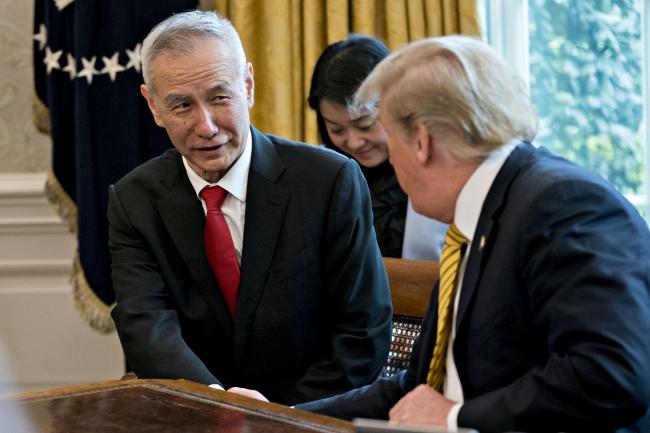(Bloomberg) -- China is considering delaying a trip by its top trade negotiators to Washington this week, according to people familiar with the matter, after U.S. President Donald Trump threatened the country with steeper tariffs over the pace of trade talks.
While a Ministry of Foreign Affairs spokesman said Monday that a Chinese delegation was still preparing to travel to the U.S. for trade talks, he didn’t answer a question about the date or whether the group would be led by Vice Premier Liu He.
“We are now trying to get more information on the relevant situation,” ministry spokesman Geng Shuang told a briefing in Beijing. “What I can tell you is that the Chinese team is preparing to travel to the U.S. for trade talks.”
Trump on Sunday raised pressure on Beijing to strike a trade deal by announcing he would increase tariffs on $200 billion of Chinese imports Friday to 25 percent from 10 percent. He also floated the possibility of extending a new 25 percent duty on another $325 billion of imports not already covered.
“Risks of a full blown trade war are escalating,” Chua Hak Bin, a senior economist at Maybank Kim Eng Research Pte. in Singapore, said before the ministry’s announcement. “Trump’s threat may backfire as China will not want to negotiate with a gun pointing at their heads.”
Liu was scheduled to arrive in Washington on Wednesday with a delegation of about 100 people for what had been shaping up to be possibly the final round of negotiations. U.S. Trade Representative Robert Lighthizer and Treasury Secretary Steven Mnuchin visited Beijing last week for talks they described as productive.
It was unclear whether the threat reflected deeper concerns by Trump, who stunned North Korean leader Kim Jong Un by walking away from their nuclear summit in February, or a negotiating tactic. The U.S. had been targeting May 10 to announce a deal, that would be finalized and signed by Trump and Chinese President Xi Jinping later at an official summit, people familiar with the negotiations said last week.
The two sides have been locked in intense negotiations since last year for an agreement to address U.S. concerns over China’s trade surplus, alleged theft of intellectual property and forced technology transfers. Trump and Xi agreed to a tariff truce on Dec. 1 to allow senior officials time to negotiate.
The truce helped soothe investors concerns about a further escalation in a trade war between the world’s two largest economies, which imposed tariffs on about $360 billion of each other’s good last year. Trump’s latest tweets mark an abrupt reversal in stance for the White House after both sides had been saying for weeks that negotiations were going well.
That shift reflects growing U.S. frustration with China’s backpedaling on some of its earlier commitments, including on the crucial matter of technology transfer, two people familiar with the situation said. That’s emboldened trade hawks within the Trump administration to push for a harder line, including the raising of tariffs, the people said.
White House economic adviser Larry Kudlow said on Fox News that the president was “issuing a warning.” While “great progress” has been made in the talks, structural and enforcement issues remained, he said.
“We hope they’ll come around with this deal, but if they don’t, the president is saying ‘Guess what, the tariffs will remain,’” Kudlow said.
Trump imposed duties of 25 percent on an initial $50 billion of Chinese goods last year and then 10 percent on an additional $200 billion in products in September. Those duties were set to rise to 25 percent on Jan. 1 and then again on March 1, but Trump delayed that as talks continued. China has imposed tariffs on $110 billion of U.S. exports in retaliation and repeatedly warned it would counter tariffs with actions of its own.
That means there’s a risk China would counter any extension of U.S. levies, though the smaller size of its imports may constrain its ability to do so.
“China isn’t likely to make concessions that the U.S. want with a big stick hanging over its head,” said Zhou Xiaoming, a former Ministry of Commerce official and diplomat. “If the tariffs that Trump threatens are implemented on Friday, China has to respond.”
Based on calculations by Bloomberg Economics, tariffs at the current level add up to a 0.5 percentage-point drag on China’s gross domestic product growth this year. An increase to 25 percent tariffs on $200 billion in Chinese exports from 10 percent would raise the drag to 0.9 percentage point. Tariffs on all of China’s exports to the U.S. would increase the burden to 1.5 point.
Just as China’s stock markets were opening, the People’s Bank or China announced it would inject 280 billion yuan ($41 billion) of longer term funds by lowering the proportion of deposits smaller banks need to lock away. Previous releases on such reserve required ratio cuts have taken place mostly in the evening or at weekends.
“The choice of announcing the targeted RRR cut today is very likely to be used to offset the negative impact of the sudden shift of the U.S.-China trade talks,” said Lu Ting, chief China economist at Nomura Holdings Inc. in Hong Kong.
